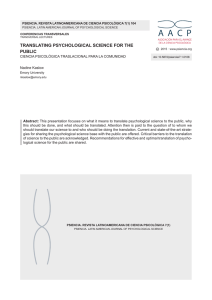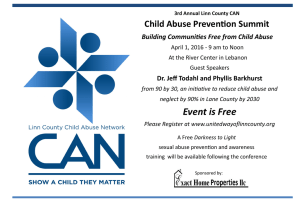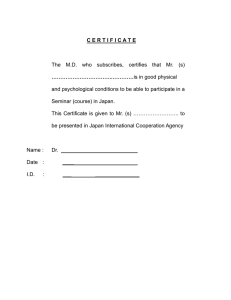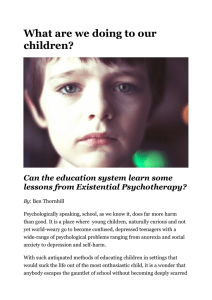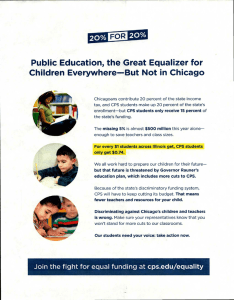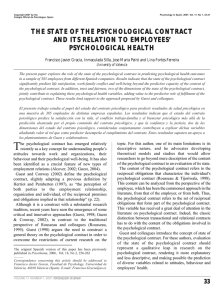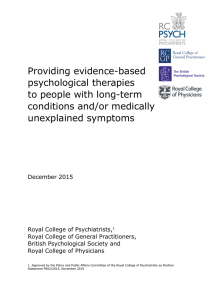Psychologists and child psychological maltreatment
Anuncio
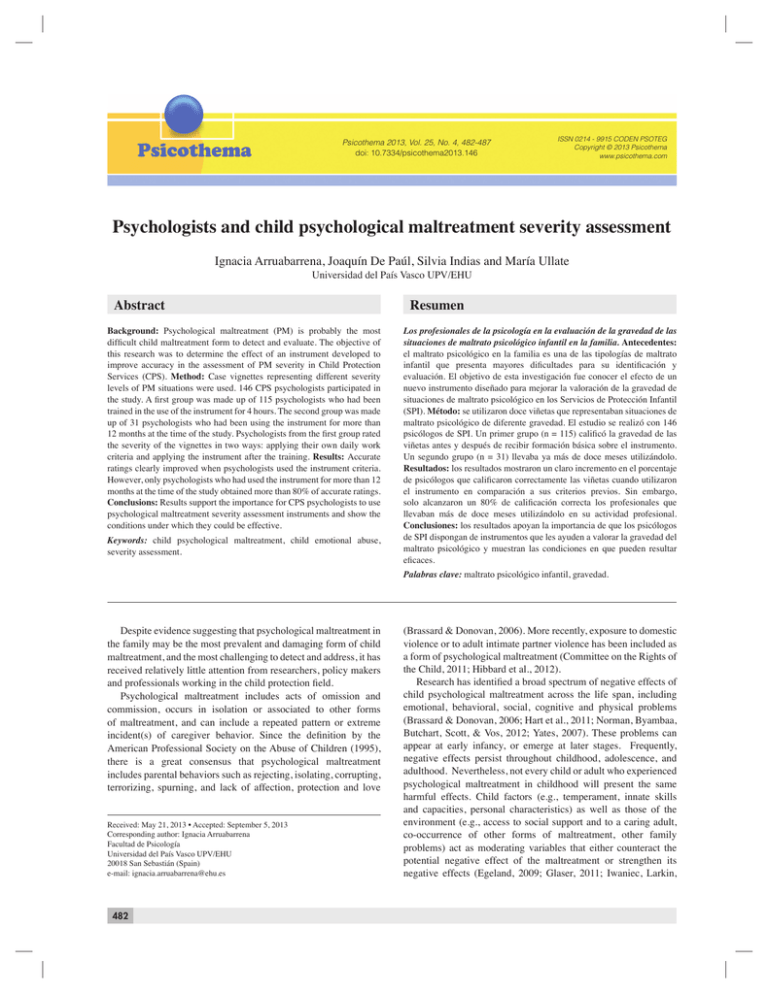
Ignacia Arruabarrena, Joaquín De Paúl, Silvia Indias and María Ullate Psicothema 2013, Vol. 25, No. 4, 482-487 doi: 10.7334/psicothema2013.146 ISSN 0214 - 9915 CODEN PSOTEG Copyright © 2013 Psicothema www.psicothema.com Psychologists and child psychological maltreatment severity assessment Ignacia Arruabarrena, Joaquín De Paúl, Silvia Indias and María Ullate Universidad del País Vasco UPV/EHU Abstract Background: Psychological maltreatment (PM) is probably the most difficult child maltreatment form to detect and evaluate. The objective of this research was to determine the effect of an instrument developed to improve accuracy in the assessment of PM severity in Child Protection Services (CPS). Method: Case vignettes representing different severity levels of PM situations were used. 146 CPS psychologists participated in the study. A first group was made up of 115 psychologists who had been trained in the use of the instrument for 4 hours. The second group was made up of 31 psychologists who had been using the instrument for more than 12 months at the time of the study. Psychologists from the first group rated the severity of the vignettes in two ways: applying their own daily work criteria and applying the instrument after the training. Results: Accurate ratings clearly improved when psychologists used the instrument criteria. However, only psychologists who had used the instrument for more than 12 months at the time of the study obtained more than 80% of accurate ratings. Conclusions: Results support the importance for CPS psychologists to use psychological maltreatment severity assessment instruments and show the conditions under which they could be effective. Keywords: child psychological maltreatment, child emotional abuse, severity assessment. Resumen Los profesionales de la psicología en la evaluación de la gravedad de las situaciones de maltrato psicológico infantil en la familia. Antecedentes: el maltrato psicológico en la familia es una de las tipologías de maltrato infantil que presenta mayores dificultades para su identificación y evaluación. El objetivo de esta investigación fue conocer el efecto de un nuevo instrumento diseñado para mejorar la valoración de la gravedad de situaciones de maltrato psicológico en los Servicios de Protección Infantil (SPI). Método: se utilizaron doce viñetas que representaban situaciones de maltrato psicológico de diferente gravedad. El estudio se realizó con 146 psicólogos de SPI. Un primer grupo (n = 115) calificó la gravedad de las viñetas antes y después de recibir formación básica sobre el instrumento. Un segundo grupo (n = 31) llevaba ya más de doce meses utilizándolo. Resultados: los resultados mostraron un claro incremento en el porcentaje de psicólogos que calificaron correctamente las viñetas cuando utilizaron el instrumento en comparación a sus criterios previos. Sin embargo, solo alcanzaron un 80% de calificación correcta los profesionales que llevaban más de doce meses utilizándolo en su actividad profesional. Conclusiones: los resultados apoyan la importancia de que los psicólogos de SPI dispongan de instrumentos que les ayuden a valorar la gravedad del maltrato psicológico y muestran las condiciones en que pueden resultar eficaces. Palabras clave: maltrato psicológico infantil, gravedad. Despite evidence suggesting that psychological maltreatment in the family may be the most prevalent and damaging form of child maltreatment, and the most challenging to detect and address, it has received relatively little attention from researchers, policy makers and professionals working in the child protection field. Psychological maltreatment includes acts of omission and commission, occurs in isolation or associated to other forms of maltreatment, and can include a repeated pattern or extreme incident(s) of caregiver behavior. Since the definition by the American Professional Society on the Abuse of Children (1995), there is a great consensus that psychological maltreatment includes parental behaviors such as rejecting, isolating, corrupting, terrorizing, spurning, and lack of affection, protection and love Received: May 21, 2013 • Accepted: September 5, 2013 Corresponding author: Ignacia Arruabarrena Facultad de Psicología Universidad del País Vasco UPV/EHU 20018 San Sebastián (Spain) e-mail: [email protected] 482 (Brassard & Donovan, 2006). More recently, exposure to domestic violence or to adult intimate partner violence has been included as a form of psychological maltreatment (Committee on the Rights of the Child, 2011; Hibbard et al., 2012). Research has identified a broad spectrum of negative effects of child psychological maltreatment across the life span, including emotional, behavioral, social, cognitive and physical problems (Brassard & Donovan, 2006; Hart et al., 2011; Norman, Byambaa, Butchart, Scott, & Vos, 2012; Yates, 2007). These problems can appear at early infancy, or emerge at later stages. Frequently, negative effects persist throughout childhood, adolescence, and adulthood. Nevertheless, not every child or adult who experienced psychological maltreatment in childhood will present the same harmful effects. Child factors (e.g., temperament, innate skills and capacities, personal characteristics) as well as those of the environment (e.g., access to social support and to a caring adult, co-occurrence of other forms of maltreatment, other family problems) act as moderating variables that either counteract the potential negative effect of the maltreatment or strengthen its negative effects (Egeland, 2009; Glaser, 2011; Iwaniec, Larkin, Psychologists and child psychological maltreatment severity assessment & Higgins, 2006). Despite the impossibility of establishing direct, unavoidable, and one-directional causes between a single experience and child development (Garbarino, 2011), it can be stated that psychological maltreatment in childhood constitutes a significant risk factor for the onset of serious and long-lasting emotional, social and cognitive problems. Even when it occurs in isolation, research has shown that the effects of psychological maltreatment are as severe, and sometimes more severe, than physical abuse, sexual abuse, or neglect. But psychological maltreatment often coexists with other forms of maltreatment, and is recognized as the core issue and the probable main influence of the most damaging and persistent sequelae of all maltreatment. In most cases of physical or sexual abuse or of physical neglect, it is not the physical act that causes significant harm to the child, but the emotional component that accompanies the abusive behavior and the emotional meaning attributed by the child to such behavior (Garbarino, 2011; Garbarino, Guttmann, & Seeley, 1986; Hart et al., 2011; O’Dougherty-Wright, Crawford, & Del Castillo, 2009). Psychological maltreatment poses many challenges for researchers and professionals. Among them are the difficulties to define, identify, and assess its severity, or to establish the threshold for Child Protection Services (CPS) intervention (Baker, 2009; Brassard & Donovan, 2006; Glaser, Prior, Auty, & Tilki, 2012; Hart et al., 2011). Literature about evidence-based preventive or treatment interventions is also scarce (Barlow & SchraderMacMillan, 2009; Hart et al., 2011), particularly when compared to other forms of maltreatment (e.g., Guastaferro, Lutzker, Graham, Shanley, & Whitaker, 2012; Olds, 2012; Urquiza & Timmer, 2012). The differentiation between poor/dysfunctional parenting and maltreatment within the parental behavior continuum is a key issue for the definition, identification and assessment of psychological maltreatment (Glaser, 2011; Slep, Heyman, & Snarr, 2011; Wolfe & McIssac, 2011). As noted by Garbarino (2011), not all inappropriate parenting behaviors have to be considered maltreatment. Several studies have shown that parental behaviors such as shouting, insulting, or threatening the children are common, with percentages ranging between 45 and 86% across studies (Dunne et al., 2009; Krug, Dahlberg, Mercy, Zwi, & Lozano, 2002; Wolfe & McIsaac, 2011). Findings show that such behaviors are perpetrated and experienced in mild or moderate forms—albeit intermittently—by most people. According to findings from retrospective studies with adults from the general population, approximately 30% may have experienced such behaviors repeatedly during childhood, and between 4-15% have experienced them in their more severe, chronic, and potentially harmful forms (Binggeli, Hart, & Brassard, 2001; Gilbert et al., 2009; Hart & Glaser, 2011; May-Chahal & Cawson, 2005). There is considerable agreement that the term psychological maltreatment should be restricted to more serious cases (Glaser, 2011; Slep et al., 2011; Wolfe & McIssac, 2011). Professionals working in CPS need to have common and clear criteria to identify cases of psychological maltreatment and to differentiate levels of severity in order to determine when CPS intervention is required, its nature and urgency, and, in Spain, the service that will be in charge of the case (community or specialized CPS). Such criteria are particularly important for psychologists, who significantly contribute to decision-making in child psychological maltreatment cases through the assessment of core issues as the emotional, social or cognitive status of the child and their parents, and the nature and quality of the parent-child relationship. Findings of a previous study carried out in Spain with two independent samples of 515 and 168 CPS caseworkers showed very low percentages of caseworkers who accurately rated the severity level of eight case vignettes reflecting hypothetical situations of psychological maltreatment (Arruabarrena & De Paúl, 2011). In another study, the effect of a new instrument (Balora instrument), which provided more specific criteria to assess maltreatment severity, was analyzed. Three groups of 515, 137, and 94 CPS caseworkers participated in the study. The instrument did not help caseworkers to assess the level of severity of the psychological maltreatment case vignettes more accurately. Percentages of accurate ratings and inter-worker agreement remained low and were not related to the number of hours of training (5, 10, or 20) that CPS caseworkers received with the instrument, their degree of experience, or their professional discipline (Arruabarrena & De Paúl, 2012). Several hypotheses were proposed to explain such findings, as the difficulties inherent to the definition and assessment of psychological maltreatment, deficiencies of the vignettes used, or limitations of the instrument itself. Consequently, the psychological maltreatment scales of the instrument were revised and modified (Arruabarrena, 2011). The present study was designed in order to explore: (a) whether the modifications included in the psychological maltreatment scales of the Balora instrument allow CPS psychologists to achieve better percentages of accuracy in the assessment of child psychological maltreatment severity, and (b) the relationship between CPS psychologists’ degree of knowledge and familiarization with the instrument and percentages of accurate ratings. Method Participants An expert group, comprised by six psychologists with extensive experience and training in child maltreatment assessment and intervention, participated in the preparation of the instruments to be used in the study (see Instruments section). Members of the expert group were selected by the research team. A total amount of 146 psychologists working in CPS participated in this study. The first group comprised 115 CPS psychologists (Group 1) from the same Spanish region, who investigate and assess child maltreatment cases in their daily work with the criteria provided by their own services. The second group was made up of 31 CPS psychologists (Group 2) from another Spanish region who had received training in the Balora instrument and who had a minimum of 12 months of daily practice with the instrument. We requested the collaboration of CPS managers to help us identify these professionals and ask them to participate in the research. Main socio-demographic characteristics of both groups are presented in Table 1. Instruments Balora instrument. The Balora instrument was developed in order to help Spanish CPS caseworkers to assess the severity of child maltreatment. Information about the development and the original version of the instrument can be found in Arruabarrena 483 Ignacia Arruabarrena, Joaquín De Paúl, Silvia Indias and María Ullate & De Paúl (2012). The psychological maltreatment scales of the original version were later modified. Their final version in the Balora instrument included four scales: Emotional abuse, Manipulation in conflicts between parental figures, Exposure to family violence, and Threat of harm (Arruabarrena, 2011). Each scale includes one or more descriptors for each level of severity (low, moderate, severe, and very severe). Case vignettes. Based on information from real case files, 12 case vignettes describing situations corresponding to each one of the severity levels of the three psychological maltreatment typologies analyzed in the present study (Emotional abuse –EA–, Manipulation in conflicts between parental figures –MC–, and Exposure to family violence –EXP–) were developed. The case vignettes were randomized and grouped into four booklets, each one of which had one vignette of each typology. The booklets were sent to each member of the expert group over successive weeks. Members of the expert group were provided with information about the typology of maltreatment described by each vignette, but not about the level of severity assigned by the research team. Each expert independently classified the severity level of the vignettes according to the criteria of the Balora instrument and sent their classification to the research team. The vignettes in which the expert group did not reach a 100% agreement were analyzed by the research team, modified, and resent for reclassification. This process was repeated as often as necessary until a 100% agreement was achieved concerning the severity level assigned to each one of the 12 vignettes. This severity level was considered “accurate.” Next, four new booklets of case vignettes were prepared, each one containing three vignettes, one of each typology. The presentation order of the typologies was identical in all the booklets, varying the severity level, which was counterbalanced. A response sheet format was prepared to register the severity level assigned to each vignette, as well as an additional form to gather information about socio-demographic characteristics of the participants. Procedure The 115 CPS psychologists from Group 1 voluntarily attended a 4-hour training session on the Balora instrument. Two sessions conducted by a member of the research team were held in two Table 1 Characteristics of participants Group 1 (N = 115) n (%) / M (SD) Group 2 (N = 31) n (%) / M (SD) Gender Female Male 83 (72.2) 32 (27.8) 25 (80.6) 6 (19.4) Type of service Community CPS Specialized CPS Both 79 (72.5) 29 (26.6) 1 (0.9) 15 (50.0) 14 (46.7) 1 (3.3) Exclusive dedication to CPS Yes No 81 (77.1) 24 (22.9) 24 (88.9) 3 (11.1) Age (years)a 42.7 (6.9) 36.2 (6.3) Experience in CPS (years) a 9.4 (6.0) 7.5 (4.7) a Mean (SD) 484 different cities. Each participant received a booklet of case vignettes and was asked to rate the severity of each vignette (a) at the beginning of the training session, applying the criteria used in their daily work (Condition A), and (b) at the end of the training session, applying the criteria of the Balora instrument (Condition B). The 31 CPS psychologists from Group 2 were contacted directly by the research team to request their participation in the study, which consisted of classifying the level of severity of the 12 vignettes using the Balora instrument. The research was carried out over four weeks. Each week, the participants received a booklet of vignettes the severity of which they had to rate and send their responses back to the research team. Data analysis To perform statistical comparisons of percentages, z-tests for two proportion analyses were used. As a large number of comparisons were performed, Bonferroni correction was used to calculate statistical significance, which was set at p<.001. Results Percentages of accurate ratings for each one of the four severity levels of each typology of psychological maltreatment and for the four severity levels conjointly are presented in Table 2. Participants were considered to make an accurate rating when assigning the same severity level as that established by the expert group. Table 2 shows that in all three typologies of psychological maltreatment and in most of the severity levels, percentages of accurate ratings were low (in most cases, lower than 50%) when the severity of case vignettes was rated using CPS psychologists´ previous criteria. Particularly noteworthy were the low levels of accurate ratings obtained for the MC very severe (28.6%) and the EXP moderate (28.1%) and very severe (15.0%) case vignettes. A more detailed analysis of the ratings obtained for these case vignettes did not reveal a common pattern of deviation; whereas in the first and third vignettes, CPS psychologists who did not classify them accurately distributed them diversely among the remaining severity levels, a remarkable percentage of them rated the second vignette in the next higher severity level. Except for some vignettes, percentages of accurate ratings increased when participants used the criteria of the Balora instrument after a 4-hour training session (differences in Group 1 between Condition A and Condition B). Nevertheless, only the group of CPS psychologists who used the criteria of the instrument after an interval of more than 12 months of familiarization (Group 2) reached satisfactory percentages of accurate ratings (higher than 80%). Taking together all the case vignettes of psychological maltreatment, z-tests revealed a statistically significant higher percentage of accurate ratings by CPS psychologists from Group 2 in comparison to CPS psychologists from Group 1, Condition A and Condition B. Considering each typology separately, only for one of the three typologies (EXP) z-tests revealed statistically significant increases in the percentage of accurate ratings by CPS psychologists from Group 1 when using the Balora instrument as compared with their previous criteria. Differences between the group of participants who used the instrument after the 4-hour training (Group 1, Condition B) and the group of participants who had used it for more than 12 months (Group 2) were significant Psychologists and child psychological maltreatment severity assessment for two typologies of psychological maltreatment: EA and MC. However, differences between the group of participants using their previous criteria (Group 1, Condition A) and the participants with more than 12 months of familiarization with the instrument (Group 2) were significant in all three typologies of psychological maltreatment and in most of the severity levels (8 out of the 12 vignettes) of the three typologies. Particularly remarkable is the low level of accurate ratings found in the latter group of participants (Group 2) for the EXP very severe vignette, which derived from the large number of participants (35.5%) who did not rate this vignette because they considered that it did not provide enough information. With a few exceptions, percentages of accurate ratings of the severity level by the group of CPS psychologists who used the Balora instrument after prolonged familiarization with it (Group 2) were clear and significantly higher than the percentages of accurate ratings by the group of CPS psychologists who used the instrument after receiving basic training but no further familiarization with its use (Group 1, Condition B). None of the three typologies of psychological maltreatment achieved 80% of accurate ratings by CPS psychologists that could be considered satisfactory, either using previous criteria or the criteria proposed by the Balora instrument after a 4-hour training session. severity of maltreatment experienced by a child or adolescent in the family– and on one of the most frequent and devastating forms of maltreatment, where such an assessment presents greater difficulty. Findings of the present study support previous studies conducted in Spain (Arruabarrena & De Paúl, 2011; Molina, 2012) and in other countries (Gambrill, 2008; Munro, 2008) that identify errors and lack of consistency as a frequent problem in the assessment processes performed by CPS caseworkers in child maltreatment cases. In general, the results show that the use of the Balora instrument significantly improves the severity assessment of hypothetical situations of child psychological maltreatment made by CPS psychologists. Such an increase occurs even with basic knowledge and limited familiarization with the instrument, although a stricter analysis only shows a statistically significant effect in CPS psychologists who have more knowledge and who are thoroughly familiar with the instrument. This latter group of psychologists reaches very satisfactory percentages of inter-worker agreement and accurate ratings, nearing or exceeding 80% in most of the case vignettes used for this research. CPS caseworkers participate in decisions that decisively affect the present and future of the children, adolescents and families involved. Psychologists play an essential and central role in the decisions ultimately adopted by CPS and the courts in cases of child psychological maltreatment, as highlighted by professional organizations (American Professional Society on the Abuse of Children, 1995; American Psychological Association, Conclusions This research focused on one of the most relevant issues that CPS psychologists have to assess in their daily work –the Table 2 Percentage of CPS psychologists who accurately rated the severity level of psychological maltreatment vignettes (Psychologists-Experts agreement) Group 1A Previous criteria Group 1B Balora inst. criteria Group 2 Familiarization with Balora inst. Significant group differences (p<.001) Emotional abuse (EA) Low 39.4 68.8 87.1 1a-2 (z = -4.58) Moderate 42.9 33.3 89.6 1a-2 (z = -3.82); 1b-2 (z = -4.79) Severe 51.9 63.0 80.6 Very severe 61.8 76.5 69.0 Total 49.6 63.2 81.7 Low 46.2 38.5 70.1 Moderate 47.1 50.0 93.5 1a-2 (z = -4.81); 1b-2 (z = -4.50) Severe 45.5 54.5 86.7 1a-2 (z = -3.90); 1b-2 (z = -3.05) Very severe 28.6 50.0 64.3 Total 43.0 48.7 79.2 1a-2 (z = -6.06); 1b-2 (z = -5.00) 1a-2 (z = -4.05); 1b-2 (z = -3.05) 1a-2 (z = -5.49); 1b-2 (z = -3.23) Manipulation in conflicts (MC) Exposure to family violence (EXP) Low 53.1 64.7 93.3 Moderate 28.1 65.6 83.9 1a-1b (z = -3.24); 1a-2 (z = -5.42) Severe 15.0 73.7 96.5 1a-1b (z = -4.59); 1a-2 (z = -9.23) Very severe 50.0 60.0 45.2 Total 39.2 65.4 79.3 1a-1b (z = -3.97); 1a-2 (z = -6.67) 1a-2 (z = -5.79); 1b-2 (z = -3.95) Total psychological maltreatment Low 46.1 58.7 83.7 Moderate 39.1 51.7 89.0 1a-2 (z = -8.08); 1b-2 (z = -5.93) Severe 40.0 62.0 87.8 1a-2 (z = -7.38); 1b-2 (z = -3.99) Very severe 51.3 64.6 59.1 Total 44.0 59.1 80.1 1a-2 (z = -6.11); 1b-2 (z = -3.57) 485 Ignacia Arruabarrena, Joaquín De Paúl, Silvia Indias and María Ullate 2013). The results of the present research support the need for CPS psychologists to have instruments that help them in the investigation and assessment of psychological maltreatment cases and to receive specific training in the use of such instruments. But that alone is not enough. A more prolonged process to obtain a deeper knowledge of and familiarization with the instrument is needed to achieve its maximum effectiveness, as also noted by Glaser et al. (2012) The potential utility of an instrument like that presented in this research is not limited to CPS psychologists, but also includes psychologists from other services, for example, mental health, educational or judicial services, who detect and frequently collaborate in the investigation and assessment of child maltreatment cases. Obviously, such an instrument does not solve all the problems that make the investigation and assessment of child psychological maltreatment so complex. This instrument provides criteria about which variables to focus on when collecting information and helps to classify such information. But it should be complemented with other guidelines and instruments that help in the observation and collection of data concerning parental behavior, the characteristics of the parent-child relationship, and the psychological status of the child, as well as rigorous knowledge of the potential short-, medium-, and long-term negative effects of certain parental behaviors and relational patterns on child well-being and development. This research presents some limitations that should be taken into consideration when interpreting its results. Among them, it was carried out with case vignettes and in an artificial context, outside of the habitual work context of CPS caseworkers. If possible, it would be important for future studies to attempt to test the functioning of this instrument by applying it to real cases and in the real context of CPS. Acknowledgements This research was supported by the Vice-Rectorate for Research of the University of the Basque Country UPV/EHU (grant number NUPV11/11). References American Professional Society on the Abuse of Children (1995). Psychosocial evaluation of suspected psychological maltreatment in children and adolescents. Practice guidelines. Chicago, IL: APSAC. American Psychological Association (2013). Guidelines for psychological evaluations in child protection matters. American Psychologist, 68, 2031. Arruabarrena, I. (2011). Maltrato psicológico a los niños, niñas y adolescentes en la familia: definición y valoración de su gravedad [Child and adolescent psychological maltreatment in the family: Definition and severity assessment]. Psychosocial Intervention, 20, 25-44. Arruabarrena, I., & De Paúl, J. (2011). Valoración de la gravedad de las situaciones de desprotección infantil por los profesionales de los Servicios de Protección Infantil [Child Protection Services caseworkers’ assessment of child maltreatment severity]. Psicothema, 23, 642-647. Arruabarrena, I., & De Paúl, J. (2012). Improving accuracy and consistency in child maltreatment severity assessment in child protection services in Spain: New set of criteria to help caseworkers in substantiation decisions. Children and Youth Services Review, 34, 666-674. Baker, A.J.L. (2009). Adult recall of childhood psychological maltreatment: Definitional strategies and challenges. Children and Youth Services Review, 31, 703-714. Barlow, J., & Schrader-MacMillan, A. (2009). Safeguarding children from emotional abuse - What works? London, UK: Department for Education. Available at: https://www.gov.uk/government/uploads/ system/uploads/attachment_data/file/189552/DCSF-RBX-09-09.pdf. pdf. Accessed: 2013-02-15 (Archived by WebCite® at http://www. webcitation.org/6Haag1q4c). Binggeli, N.J., Hart, S.N., & Brassard, M.R. (2001). Psychological maltreatment of children: The APSAC study guides 4. Thousand Oaks, CA: Sage Publications. Brassard, M.R., & Donovan, K.L. (2006). Defining psychological maltreatment. In M.M. Feerick, J.F. Knutson, P.K. Trickett, & S.M. Flanzer (Eds.), Child abuse and neglect. Definitions, classifications, and a framework for research (pp. 151-197). Baltimore, MD: Paul H. Brookes. Committee on the Rights of the Child (2011). General Comment No. 13. Article 19: The right of the child to freedom from all forms of violence. http://srsg.violenceagainstchildren.org/sites/default/files/documents/ docs/crc-c-gc-13_EN.pdf. Accessed: 2013-02-15 (Archived by WebCite® at http://www.webcitation.org/6HaaAudBa). Dunne, M.P., Zolotor, A.J., Runyan, D.K., Andreva-Miller, I., Choo, Y.W., Gerbaka, B., ….. Youssef, R. (2009). ISPCAN Child Abuse Screening 486 Tools Retrospective version (ICAST-R): Delphi study and field testing in seven countries. Child Abuse & Neglect, 33, 815-825. Egeland, B. (2009). Taking stock: Childhood emotional maltreatment and developmental psychopathology. Child Abuse & Neglect, 33, 22-26. Gambrill, E. (2008). Decision making in child welfare: Constraints and potentials. In D. Lindsey & A. Shlonsky (Eds.), Child welfare research. Advances for practice and policy (pp. 175-193). New York: Oxford University Press. Garbarino, J. (2011). Not all bad treatment is psychological maltreatment. Child Abuse & Neglect, 35, 797-801. Garbarino, J., Guttmann, E., & Seeley, J.W. (1986). The psychologically battered child. Strategies for identification, assessment, and intervention. San Francisco: Jossey-Bass. Gilbert, R., Widom, C.S., Browne, K., Fergusson, D., Webb, E., & Janson, S. (2009). Burden and consequences of child maltreatment in highincome countries. The Lancet, 373, 68-81. Glaser, D. (2011). How to deal with emotional abuse and neglect – Further development of a conceptual framework (FRAMEA). Child Abuse & Neglect, 35, 866-875. Glaser, D., Prior, V., Auty, K., & Tilki, S. (2012). Does training in a systematic approach to emotional abuse improve the quality of children’s services? London: DfE. Available at: https://www.gov.uk/ government/uploads/system/uploads/attachment_data/file/181602/ DFE-RB196.pdf. Accessed: 2013-02-15 (Archived by WebCite® at http://www.webcitation.org/6GmaxR9hD). Guastaferro, K.M., Lutzker, J.R., Graham, M.L., Shanley, J.R., & Whitaker, D.J. (2012). SafeCare: Historical perspective and dynamic development of an evidence-based scaled-up model for the prevention of child maltreatment [SafeCare: perspectiva histórica, desarrollo dinámico y diseminación de un programa de prevención del maltrato infantil basado en la evidencia]. Psychosocial Intervention, 21, 171-180. Hart, S.N., Brassard, M.B., Davidson, H.A., Rivelis, E., Díaz, V., & Binggeli, N. J. (2011). Psychological maltreatment. In J.E.B. Myers (Ed.), The APSAC handbook on child maltreatment (3rd ed.) (pp. 125144). Thousand Oaks, CA: Sage. Hart, S. N., & Glaser, D. (2011). Psychological maltreatment – Maltreatment of the mind: A catalyst for advancing child protection toward proactive primary prevention and promotion of personal well-being. Child Abuse & Neglect, 35, 758-766. Hibbard, R., Barlow, J., MacMillan, H., American Academy of Pediatrics, Committee on Child Abuse and Neglect, & American Academy of Child and Adolescent Psychiatry, Child Maltreatment and Violence Psychologists and child psychological maltreatment severity assessment Committee (2012). Psychological maltreatment. Pediatrics, 130, 372378. Iwaniec, D., Larkin, E., & Higgins, S. (2006). Research review: Risk and resilience in cases of emotional abuse. Child and Family Social Work, 11, 73-82. Krug, E.G., Dahlberg, L.L., Mercy, J.A., Zwi, A.B., & Lozano, R. (Eds.) (2002). World report on violence and health. Geneva, Switzerland: World Health Organization. Available at: http://whqlibdoc.who. int/publications/2002/9241545615_eng.pdf. Accessed: 2013-02-15 (Archived by WebCite® at http://www.webcitation.org/6Gmb3VvOe). May-Chahal, C., & Cawson, P. (2005). Measuring child maltreatment in the United Kingdom: A study of the prevalence of child abuse and neglect. Child Abuse & Neglect, 29, 969-984. Molina, A. (2012). Toma de decisiones profesionales en el Sistema de Protección a la Infancia [Professional decision making in the Child Protection System]. Junta de Andalucía, Granada. Available at: http:// www.juntadeandalucia.es/observatoriodelainfancia/oia/esp/descargar. aspx?id=3586&tipo=documento. Accessed: 2013-02-15 (Archived by WebCite® at http://www.webcitation.org/6Gmb90PAB). Munro, E. (2008). Lessons from research on decision making. In D. Lindsey & A. Shlonsky (Eds.), Child welfare research. Advances for practice and policy (pp. 194-200). New York: Oxford University Press. Norman, R.E., Byambaa, M., De, R., Butchart, A., Scott, J., & Vos, T. (2012). The long-term health consequences of child physical abuse, emotional abuse, and neglect: A systematic review and meta-analysis. PLOS Medicine, 9, e1001349. O’Dougherty-Wright, M., Crawford, E., & Del Castillo, D. (2009). Childhood emotional maltreatment and later psychological distress among college students: The mediating role of maladaptive schemas. Child Abuse & Neglect, 33, 59-68. Olds, D.L. (2012). Improving the life chances of vulnerable children and families with prenatal and infancy support of parents: The Nurse-Family Partnership [Un programa de apoyo parental prenatal e infantil para mejorar las oportunidades vitales de niños y niñas de familias vulnerables: el Nurse-Family Partnership]. Psychosocial Intervention, 21, 129-143. Slep, A.M., Heyman, R.E., & Snarr, J.D. (2011). Child emotional aggression and abuse: Definitions and prevalence. Child Abuse & Neglect, 35, 783796. Urquiza, A., & Timmer, S. (2012). Parent-Child Interaction Therapy: Enhancing parent-child relationships [Un programa para la mejora de las relaciones padres-hijos. La Terapia de Interacción Padres-hijos]. Psychosocial Intervention, 21, 145-156 Wolfe, D.A., & McIsaac, C. (2011). Distinguishing between poor/ dysfunctional parenting and child emotional maltreatment. Child Abuse & Neglect, 35, 802-813. Yates, T.M. (2007). The developmental consequences of child emotional abuse: A neurodevelopmental perspective. Journal of Emotional Abuse, 7(2), 9-34. 487
